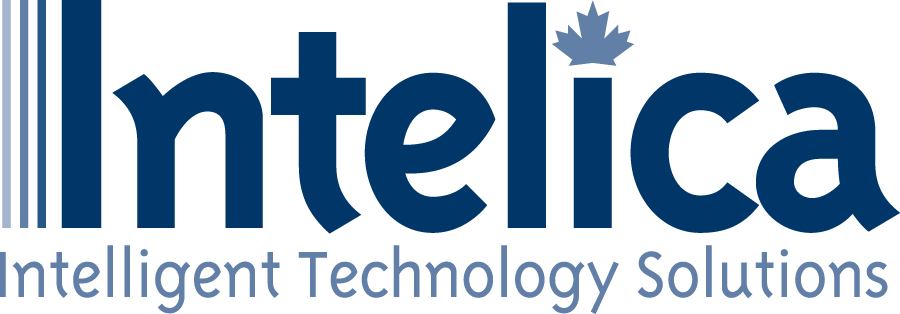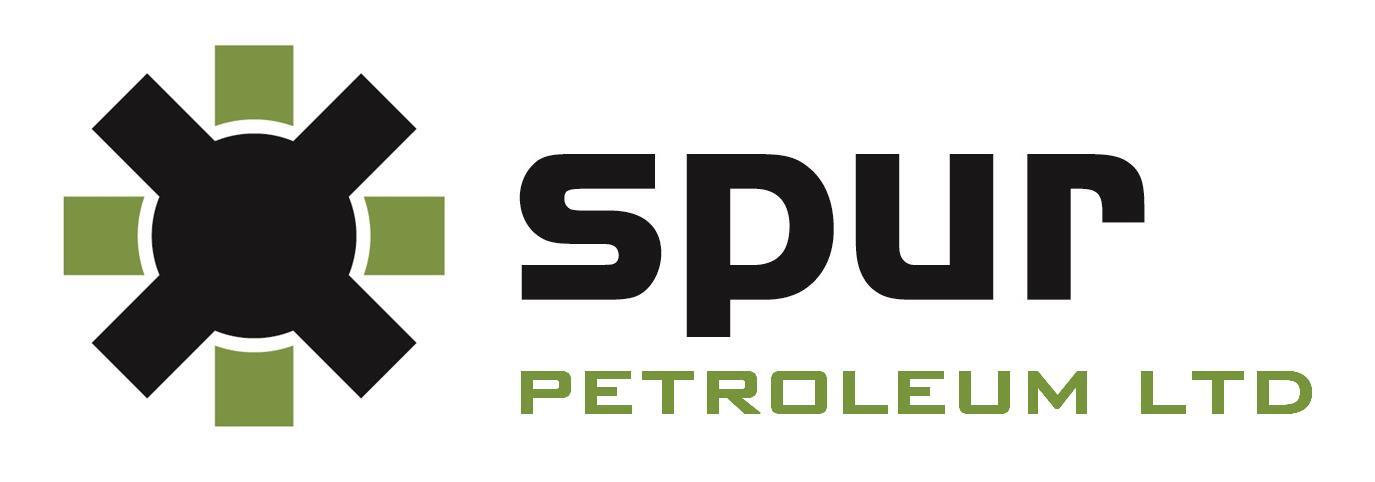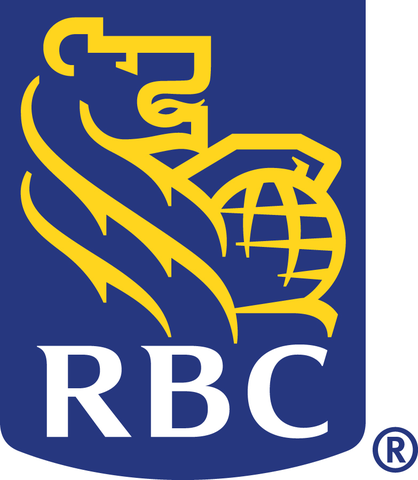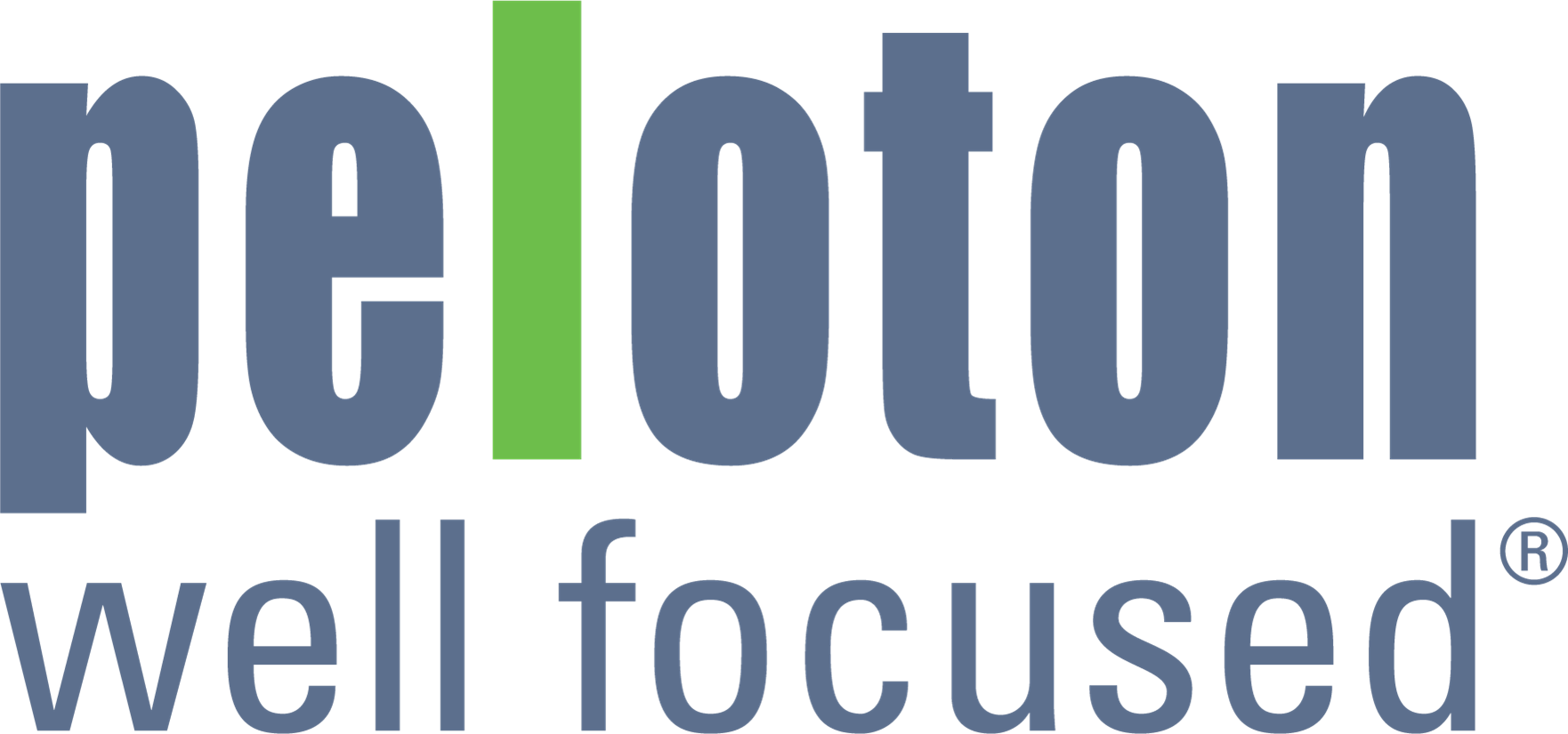I have tried multiple times to write and share Ella’s story. I struggle partly because I feel this is her story to tell, not mine, but the other struggle is I know that by the time I finish writing this, there will be more to add to it. We are anxiously waiting to hear when Ella’s next brain surgery will be. We know it will only be weeks away. The outcome of this surgery has so many possibilities and we know this because she has already been through three within the last year. That is not including the other surgeries. That is just her brain surgeries. At the young age of three, the number of brain surgeries she will have is more than her age.
Ella has always been such a strong, determined little girl. She reached all her milestones well before anyone else in any of her baby classes. But the term little really is the key word. At just five months, she had been referred to a pediatrician because our family doctor was concerned that she just wasn’t gaining as well as she should be. She went through every test at the time to rule everything out. She even went to a neurologist because of some shaking she was doing. Every test came back okay. Back to regular life and the doctor appointments began to slow down to just her regular checkups.
Once, when she went for bloodwork at the Alberta Children’s Hospital, something in me had a calming feeling take over. I vividly remember thinking, “This is home.” Seeing the oncology sign gave me such a strong sense of home. Such a strange thought to have at the time.
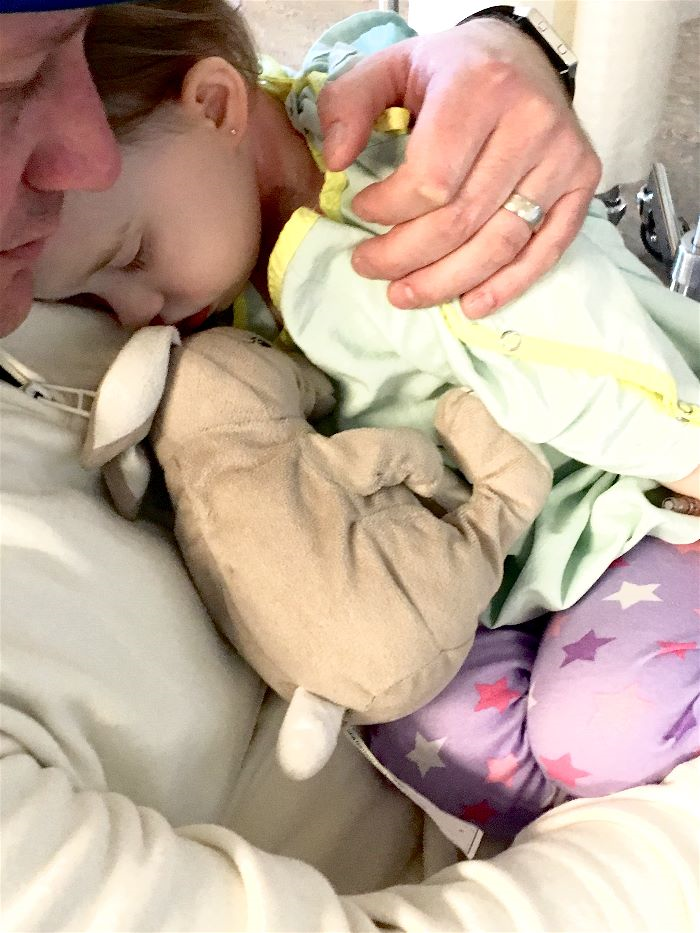
Looking back, we now note that she would wake up not being able to walk straight and shake. Blood sugar, we were told, was the reason. Around the age of two, when she was really tired her eye would turn in, but it never stayed that way. It seemed as though you could “snap” her out of it. Sometimes she even thought she was being funny doing it. She would fight each and every time we put her into the car seat. Even on really hot days, she would say she didn’t want to get in her car seat because her head hurt. On the first hottest day of the year, she threw up – but we figured she just hadn’t drank enough fluids at daycare. Some days, she would throw up in the mornings, but feel better afterwards.
When her sister was born, Reese had to stay in the Neonatal Intensive Care Unit as she needed to be monitored. It was then that Ella’s eye turned in and stayed in this time. The day I was finally released from the hospital, after some complications during labour, we decided to take Ella to her optometrist. He sent a referral home with us, telling us to go to the emergency room. We went straight to the Alberta Children’s Hospital and while we were seeing an emergency doctor, we received a call about a referral to an ophthalmologist, who was just on the second floor above us. The ER doctor was fairly certain this was just a lazy eye, as it is common at the age of two for this to happen, but he sent us upstairs just to be certain. All the tests you could think of were done on her eye and nothing seemed unusual. They also confirmed that it was just a lazy eye and we were to start patching her good eye and come back for routine check-ups to see if there were any improvements. Ella was doing well at all follow-ups and was even showing some small improvements.

That’s when Ella started waking up in the middle of the night, saying her head hurt. She would say she needed a towel on her head to make it feel better. One day, while visiting family, she said she needed Aunty to give her medicine. Aunty gave her water in a medicine cup and Ella went back to bed saying her head was all better. Migraines run in my family, so we were not too concerned, but we did take her to her family doctor to see if there was anything we could do. She asked us to monitor it and said if she continued to wake up complaining of her head hurting, to come back the next week. I took her into the doctor the next week. The doctor gave me a letter to give to the emergency doctor. She said, “Let’s just give us some peace of mind.”
It didn’t seem like it a big concern and since her sister Reese was having at least four appointments a week at that time, we decided we would bring Ella in the next day. The next day, June 5, 2017, I took Reese for her four-month follow-up and Lyle took Ella to the Alberta Children’s Hospital. They gave Ella a CT scan and while I was at Reese’s doctor appointment, they were waiting on the results of her scan. It was taking hours and Lyle and I both figured the scan was okay. We figured they were seeing the high priority patients first. Little did we know that it was taking so long because they were getting a team of doctors together to speak with Lyle.
That day, Reese finally got the all-clear. We no longer had to continue with so many medical appointments. That’s when I received a text from Lyle, saying, “Call when you can.” He then called and said, “Just get to the hospital.” That’s when I knew something was wrong.
On my drive there, Lyle was able to leave Ella’s room and call me back and tell me the words that you never think you will ever hear. “They found a tumour in her brain.”
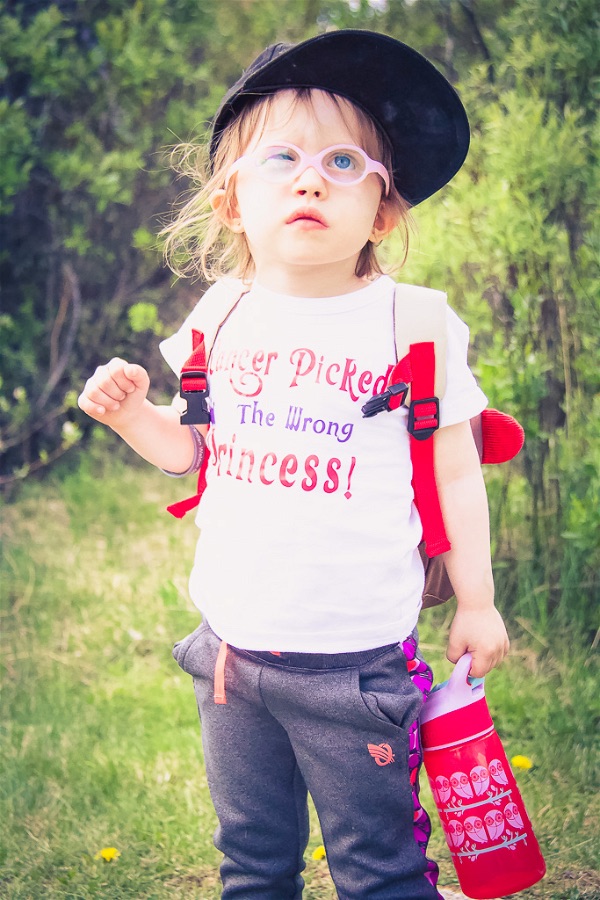
I wish I could recall the rest of the day and tell you exactly what happened, but I had become numb. Everything was a blur. When I got to the hospital, Dr. Gallagher came into see us and so matter of factly told us that Ella was not going to be going home today. Instead, she was admitted right away to unit 3. She needed to be monitored very closely every hour, day and night. She was scheduled for an MRI the next day (Thursday) and was scheduled Friday for a surgery to try and remove the tumour. We didn’t leave Ella’s side after that. Family all came and we were all taking in as much as we could, taking pictures and videos to try and have as many memories as possible in case the unthinkable happened.
“There are things far worse than death.” This statement still haunts me today. It is a statement someone said to us, when preparing us for her surgery. Ella’s tumour was the size of a lemon, we were told, and it originated in her brainstem. The brainstem is responsible for basic functions such as breathing, heart rate and body temperature. There was no cerebral fluid in sight on the MRI, severe hydrocephalus, an accumulation of cerebrospinal fluid (CSF) within the brain. The tumour was that large, the major artery in her brain was nowhere to be seen either. They wouldn’t know what to expect until they were able to get her into surgery. This surgery was emergency surgery; not just to remove the tumour, but to save her life.
Friday was the longest day of our lives. The hospital floors were worn down just a little bit more from us pacing back and forth for nine hours. We received the page that we were finally able to go see Ella. Lyle and I ran as fast as we could through the doors of the Pediatric Intensive Care Unit (PICU). I don’t know if anything could have prepared me for seeing my little girl the way she was that Friday night. She was hooked up to every machine and had an external ventricular vein (EDV) – which is a little tube draining cerebrospinal fluid from the top of her head. Intravenous (IV) tubes were everywhere. She was fighting everyone. No one could calm her down. She didn’t sound like herself. The nurses immediately saw me and asked me to sit down and hold Ella to try and calm her down. I was unsuccessful. I can’t even begin to describe the feeling you get, seeing your child in so much pain and being so helpless.
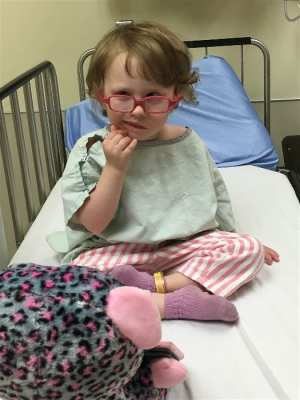
We also found out that they were only able to do a partial resection of the tumour. The team of surgeons felt they could not get any closer without doing damage. Ella’s tumour is considered incurable. Due to the location, they cannot fully remove it. It will always be there and it will always grow. We were told this is the worst spot for a brain tumour to be.
Ella was fighting so much, that it would sometimes take up to six adults to hold her down. The EDV was draining fluid, so if she moved from her position it would have to be adjusted. Otherwise she too much pressure would build up and would cause more pain. Every time she moved, we would have to clamp her until she calmed down. This would also build up pressure in her brain. It was a no-win situation. I am beyond thankful that she is such a strong girl, but this time she was fighting the wrong fight. She needed rest. She needed to heal.
Over the next few days, Ella started having difficulties breathing. She was only scheduled to stay one night in the PICU; however, because of the complications, she stayed a full week before moving up to unit 3. There was so much swelling in her throat that she needed help to just breathe. At that time, they did not know if the swelling was due to damage caused during surgery, removal of the tumour, or just from having multiple breathing tubes switched out during her operation. While in the PICU, she also caught an infection, so was put in isolation.
Imagine being 2.5 years old, having to be tied down and slightly sedated constantly so you don’t rip out your EDV or your breathing tube and only seeing doctors in yellow gowns and masks. I’ll never be able to erase that fear from Ella’s mind. She also needed a feeding tube, which she ripped out. After that she just didn’t eat. The fear was if another one was put in, she would just rip it out, or confuse it with her EDV, and potentially rip that one out as well.
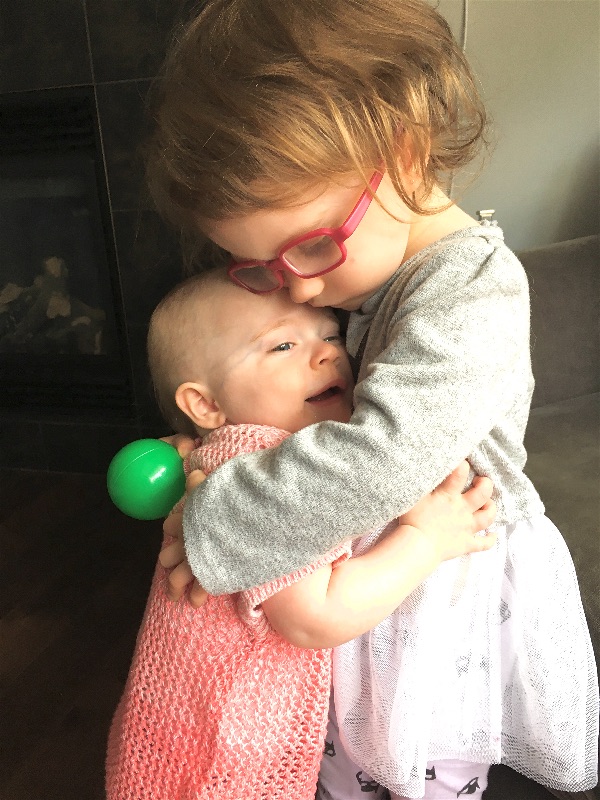
We were told almost right away to be prepared; Ella would need a shunt – to help drain her fluid due to the location of the tumour. But they were going to give it some time to see what time would do. She then caught a severe case of pneumonia on top of the other infection she had. Whether or not she needed a shunt would have to wait until that was over. Throughout the next week, Ella was still having outbursts where it would take many adults to hold her down. Sometimes it would last 30 minutes and sometimes hours. This we learned was called posterior fossa syndrome. Posterior fossa syndrome has a whole range of symptoms, which can include problems with coordination, speech, swallowing, speaking and emotional difficulties which include mood swings, agitation and angry behaviour.
During one of her outbursts, they realised that the stitching from surgery had opened up and her cerebral fluid was leaking. It was all over her pillow. Even with pneumonia, she needed a shunt put in right away.
Off she went for her second brain surgery. During that surgery, once her skull was opened up, they could see she was so badly infected, they could not risk putting a shunt in. The risk for meningitis was too high. Instead they “washed” Ella’s brain and tried to get it as clean as possible. We would have to wait for her to recover from her infection before they tried again.
Knowing that Ellas was going to need another surgery, she was also always NPO – nil per os, a Latin phrase that literally translates into English as “nothing through the mouth.” She wasn’t able to eat or drink or have anything by mouth. She had constant IV fluids, but she eventually needed TPN, which is total parenteral nutrition, a way of feeding patients all the essential nutrients they need intravenously. She needed nutrition. She had gone far too long without nutrients. As a 2.5-year-old, she was wasting away before our eyes. She had been poked with bloodwork so many times – daily – and needed TPN for so long that it started taking a toll on her veins and her veins started failing. The TPN ended up leaking out of her veins and causing so much damage that a plastic surgeon had to come look at her poor arm, which was double the size of what it should be. It caused her so much pain, she would just cry from then on anytime she thought you were getting close to her to try and “poke” her. She became obsessed with band aids, but the hospital ones just wouldn’t do. We would have to bring some from home every day. Paw Patrol, Princess, Avengers – anything that wasn’t from the hospital. She would put them all over herself. It was the only way she would allow pokes.
It was around this time that she was finally allowed to start eating food. There was still so much damage to her throat that a bit of yogurt made her aspirate. She had to learn how to eat all over again without choking with each bite. Things were so bad that even when we tried to get her to finally brush her teeth, she would aspirate with that. She had to start therapy just to help her eat. It took about six months post ops for her to start gaining confidence in her eating again. Even now, depending on what she eats, she can still cough and have some problems.
Finally, after three weeks in the hospital, that’s three weeks of blood tests and pokes every day and being in isolation, we were given the OK to have her third craniotomy – to have a shunt put in place. The surgery was a success and they were finally able to do the surgery and get the EDV out. This meant she was finally able to get out of bed without having to worry about clamping her EDV. She could finally move freely.
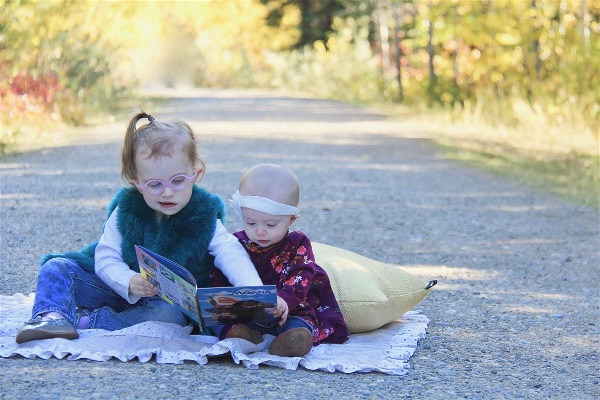
We stayed in the hospital for another week after these procedures as she was still not fully recovering as well as she should be. Every day in the hospital Ella would have some type of therapy. She needed to practice just sitting up and holding her head by herself. I will never forget the day she was going to have another feeding tube put in. Our neurosurgeon told us she strongly believed that Ella’s mental health was preventing her physical health from getting better. We were given a day pass, which turned into a night pass, which turned into a discharge the next day. If all had gone well, Ella was expected to have a hospital stay of only five days. But, by the time she was discharge, her stay had been four weeks.
There are many side effects from all of the surgeries and from the tumour itself. Ella now has facial palsy on her left side. It has made her eye closing fully impossible. Her left eye never closes. It has become so dry that there is a real concern for her to lose the sight in that eye. She is scheduled soon for another surgery to partially stitch her eye and will eventually need a weight placed in her eyelid to help close it. With her right eye open, they suspect she sees double. Because of that, she does not like to open that eye. If she keeps that eye shut for long enough, her brain may decide to shut off that eye. Ella also has ataxi – meaning her balance is extremely off. With the growth she has now seen, her balance and ability to walk has been even more affected. She receives therapy for that, which has helped her adapt to her capabilities. Ella has also lost all of her hearing in her left ear. Light bothers her and she also becomes over-stimulated easily and quickly. Then she struggles to calm down afterwards. She has started to realize that she struggles to keep up with her friends and you can see that each and every day her confidence is slipping away. She sometimes cries when we say we are going to the park and begs us not to leave the house. Unfortunately, this may not be the end of the list of her deficiencies.
Things were very slow in her recovery, we had multiple appointments each week with different specialists. Ella was put on a watch-and-wait schedule for her tumour with an MRI done every three months. Usually she requires a quick MRI between each one. By January of 2018, her tumour had grown 75 per cent – enough to realize that chemotherapy was necessary to help stabilize the tumour. Chemotherapy also has long-term effects that will not present until later in life.
The week after she was discharged, Ella was scheduled to have an IVAD put in to make accessing her veins and having treatments easier. An IVAD is a small device that is inserted under your skin. It is attached to a catheter in your chest and the catheter is inserted into a vein. She is in the middle of 70 weeks of chemotherapy with the assumption that the rest of her life will be an endless cycle of chemo and surgeries. She is on the lowest dose of chemo, which should give little to no side effects. Except, Ella seems to be the exception to all the rules and experiencing the rarest of side effects.
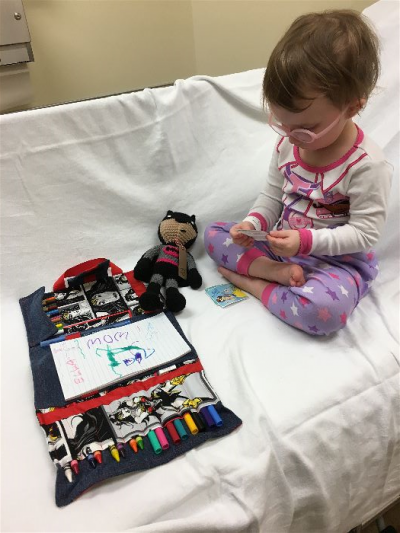
While on chemotherapy, fevers are very serious. Ella needs to go into the hospital and have blood drawn and go on preventive antibiotics. She would always get a fever while on treatment and would always end up in the hospital. Finally, after a few months, they realized that the fever is a symptom and she does not have to go in every time. Her hair has started to thin. She now gets sick and has more down days than good days. She will have short bursts of energy, but it takes so much out of her that she has to spend hours lying down.
Ella just received another MRI, after being on treatment for six months. There is a tumour cyst that has grown four times the size since last year. It is pressing on her cerebellum and causing even more balance issues. Her fourth ventricle is crushed and is not allowing fluid to flow. Now we start the process all over again – surgery where they will go in and drain the cyst and try to debulk more tumour. This will hopefully prevent the need for a second shunt to be inserted.
Going through something like this, as a family is extremely isolating. Of course, friends and family try to understand what you are goingthrough, but it is something that it just too difficult to explain. We hear over and over that Ella looks great and because you can’t see her tumour growing, or the effects it has taken on her emotionally, it is hard to understand the constant fear that is in your mind every single day, every waking moment. Every cough, every fall, every illness terrifies you.
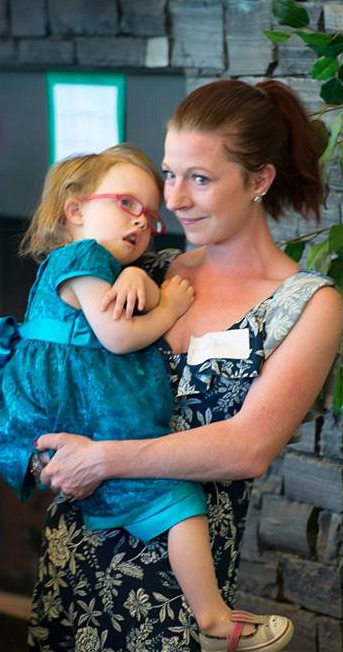
In our darkest days, we have met some incredible people, either families going through their own similar stories, or foundations like Kids Cancer Care that are there to help. These people are beyond amazing. Everyone has gone out of their way to make sure Ella feels as comfortable and confident as she possibly can.
Through Kids Cancer Care, Ella goes to a gym class called PEER that runs throughout the school year. It is held at the Gordon Townsend Gymnasium at the hospital and it has so many other kids Ella’s age. It is such a wonderful class and they even have a one-to-one aide for Ella, as she needs extra help and encouragement. It is so great to see her at the end of every class with a smile on her face. This summer, Carolina, the instructor, even reached out to us to keep seeing Ella, just so she doesn’t lose any of the progress she was making. Carolina didn’t have to do this – it is something that she chose to do just out of the kindness of her heart. That is how they are at Kids Cancer Care.
We had the opportunity to see Camp Kindle for the first time on Mother’s Day, because Kids Cancer Care had planned something for all the moms and families. There were arts and crafts, volunteers for the kids and massages for the moms. Ella had so much fun; she talked about Camp Kindle all the time after that. When Kids Cancer Care held their Spring Family Camp, she was so excited to be able to go. Even though she was a little apprehensive to participate and play with many of the other kids, you could constantly see a smile, playing on her face.
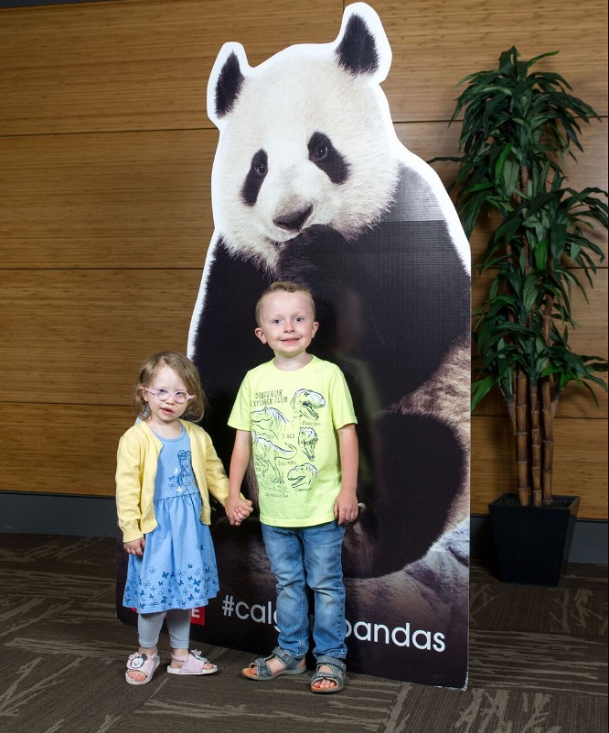
By the time summer came this year and I found out that Kids Cancer Care offered a week-long day camp, I had to sign Ella up. I was a little afraid, because Ella has never been without me or Lyle by her side for that long since she was diagnosed. But they assured me that Camp SunRise would have enough volunteers to give Ella a one-to-one camp aide. We even got to go to Kids Cancer Care the week before camp started, so Ella could meet her camp volunteer, whose camp name is Cookie. Ella still has a picture of her and Cookie that she still looks at. She also still talks about her new friend Henry she met at camp. They even got to see each other again at the Panda Breakfast, Kids Cancer Care and the Calgary Zoo hosted, so kids on treatment would have a chance to see the pandas too. Ella is unable to go to Henry’s birthday party this year, so Ella and Henry are having a party earlier just so she doesn’t miss yet another experience. It is amazing what all these camps and activities are doing for Ella’s self-esteem, confidence and overall happiness. You can see just how far she has come in such a short time and we owe so much to Kids Cancer Care. We get emails from people just to check-in and see how we are doing. And we are always invited to all of the activities or camps that are going on.

I don’t wish this on anyone, but I am so thankful for the support systems that are put in place to help. These kids miss out on so much in life because most of them cannot risk getting sick. They are forced to grow up so quickly and to deal with things that most adults are not even capable of dealing with. To have a safe place to go and just be kids, there are no words to describe my gratitude.
We are learning as we go and we may have setbacks, but with all of that, one thing that we will always have is hope. By meeting others in similar situations, we have been given a chance to see just how strong a community Kids Cancer Care is. No one chooses to be part of this community, but we make sure we all feel like family. One day at a time and we will deal with every surgery, treatment, problem and complication that comes our way with our family. Ella is my hero.
– Christie Reimer, Ella’s mom





















